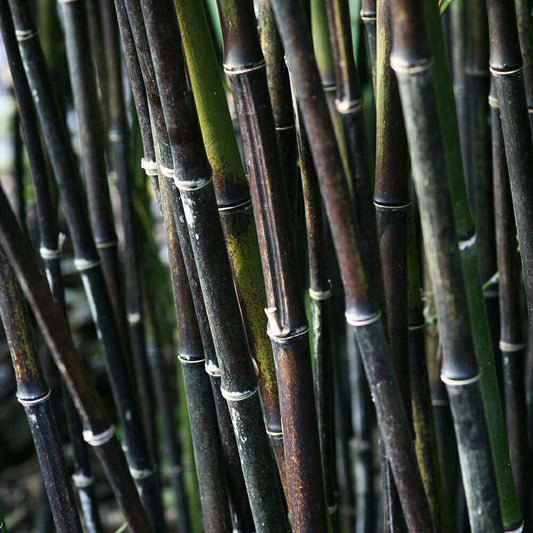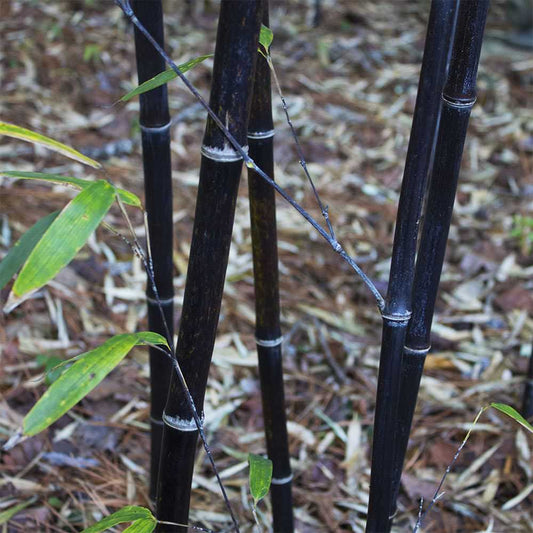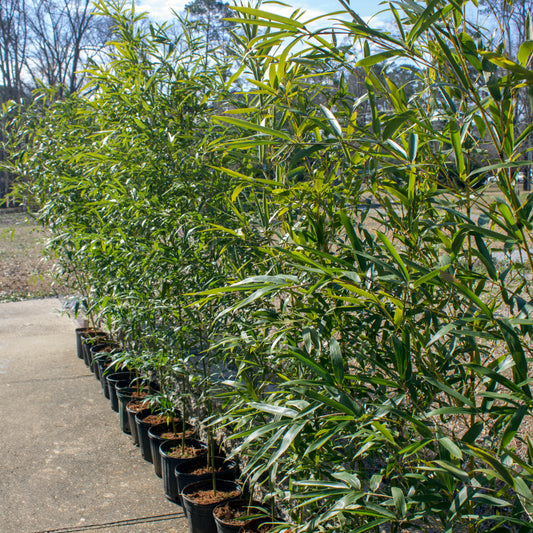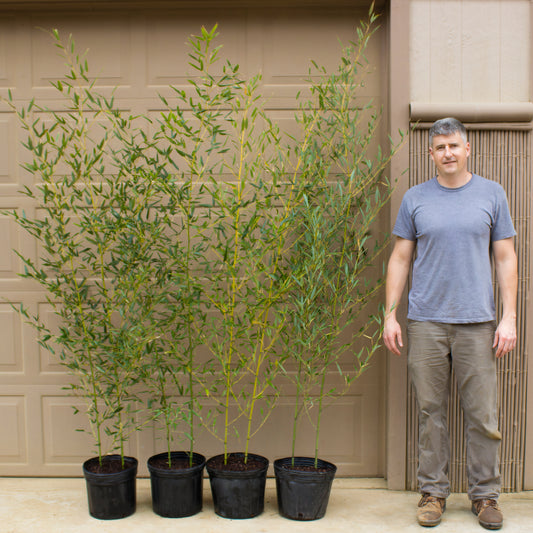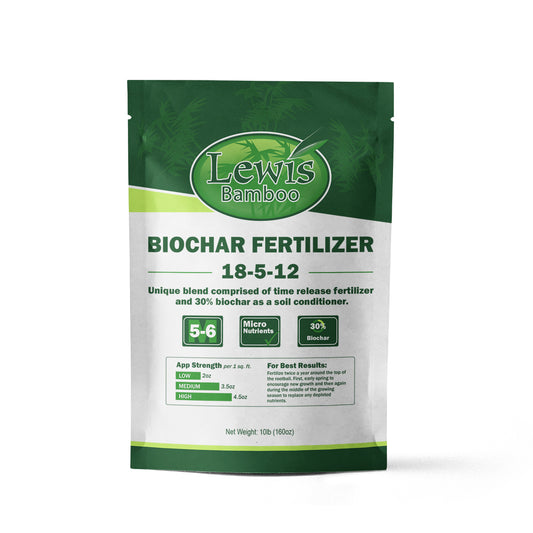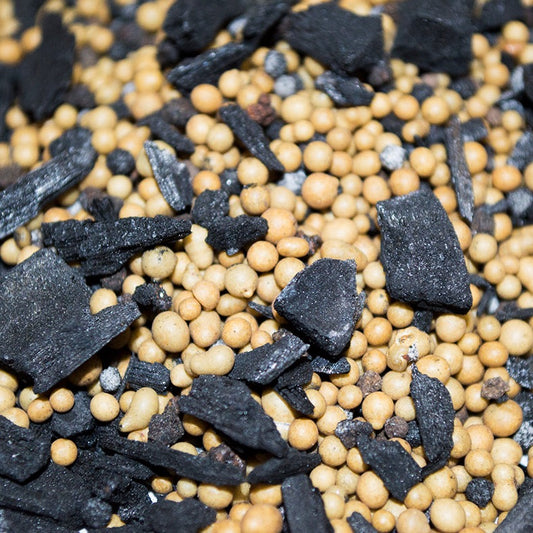Frequently Asked Bamboo Questions
Where are you located and can we visit your nursery?
We are located 50 miles west of Birmingham, AL on 60 acres of waterfront property and yes you can visit to purchase bamboo at the farm. Lewis Bamboo Inc. is a state-licensed bamboo nursery and can mail order nationwide. Our retail nursery offers on-site purchases plus mail orders. For information about appointments click here.
What do you mean by a gallon size?
We use standard nursery size containers. Plants are removed from the original container and wrapped for secure shipping.
Gallons = Width x Height (In Inches)
1 gallon = 7.5″ x 6.5″
2 gallon = 8.5″ x 8.5″
3 gallon = 10.7″ x 9.25″
15 gallon = 18.25″ x 16″
25 gallon = 24″ x 18″
More details about shipping and plant sizes
Is Bamboo safe for pets?
Bamboo is not toxic to dogs, cats, or horses. The foliage can contain up to 22% protein! This makes bamboo a great house plant and allows you not to worry about your little (or big!) friends.
Do be careful about some bamboo look-alike species. While they are not bamboo at all, many have “bamboo” in the name. Lucky Bamboo & Heavenly/Sacred Bamboo are both toxic to dogs, cats, and horses.
Read Is Bamboo Safe for Pets? & Plants Mistaken for Bamboo
What is a Field Specimen?
These are larger plants that are unavailable for delivery by UPS. Typical sizes are 15 gallon (10′-15′ tall) and 30 gallon (15′-25′ tall). They can be picked up at our nursery or we will be happy to deliver them personally on one of our trucks and trailers. See our wholesale sizes page for more details.
How many plants are in a container?
Most screening species have 1-3 culms (canes) per plant. Since bamboo is a grass and colony plant, dividing them will only hurt growth. Each container should be considered as one plant and not be divided.
How many bamboo plants do I need to form a privacy screen type grove?
One division of bamboo will start a grove or screen over time. However, if you want a privacy screen fast, we recommend planting 3-gallon sizes 3 to 5 feet apart, plant 2 gallon sizes 1 to 3 feet apart. This will hopefully allow you to have a good screen in three years. There are a lot of factors such as water, sunlight, and climate zones that speeds up or slows down the process. Three years is about the average on this spacing, closer planting will allow you to screen or develop your grove faster. You cannot over plant bamboo.
How do I control bamboo?
Temperate bamboo typically flowers on 75 year cycles and has a very poor seed set. Bamboo spreads through rhizome (root) expansion. Control the root expansion and you will control bamboo.
See natural control methods or for reduced maintenance, install Bamboo Shield.
Do I need running or clumping bamboo?
Clumping bamboos are slower to form screens and have very limited applications because they are picky about climate zones. Running bamboo are fast to screen and there are species suitable for almost any climate zone. Running bamboo just needs to have the root system controlled.
See running vs clumping bamboo.
Do you have any bamboo seeds I can purchase?
Sorry, bamboo flowers very seldom and the seeds are only viable for a very short time. Some species have never been documented flowering while others go 100 years or longer between flowering. Seeds are often available from other countries such as China, but these are usually confiscated by custom authorities as they enter the country and discarded. Seeds are subject to the same quarantine regulations as live plants (Notice of Quarantine, 7 CFR § 319.34). Bamboo seeds bought on E-Bay are buyer beware and not recommended. Propagation by seeds is a very difficult task and high attrition rates will be experienced.
Do you have any Lucky Bamboo
We do not carry Luck Bamboo because it is not a true bamboo. This plant is a member of the Lily family or Liliaceae and is not a bamboo. There are several different types of this plant, but the most common is Dracaena Sanderana. There are many other plants that are mistaken for bamboo. More Details.
How often do I water and fertilize my new bamboo?
Watering
During the first few weeks, water the plant regularly. Soak the soil and spray the leaves. Bamboo likes water but loves drainage. Water heavily but make sure that you are allowing your planting site time to drain between watering cycles. This time can vary depending upon the time of year, soil composition, slope, etc.
Fertilizing
We have our custom mix Bamboo Fertilizer available. It consists of a time-release fertilizer accompanied by a bamboo biochar additive to allow time for proper absorption rate. It is the best mixture we have found after 20 years of trials. We fertilize twice a year. Fertilize in early spring (to encourage new growth) and then again during the middle of the growing season (replace any nutrients that may be getting depleted).
There are some leaves turning yellow on my bamboo, is it dying?
This is normal throughout the year, however, it is most noticeable during the Springtime. All leaves will be replaced over the course of one year, so naturally, you will see a lot of yellow and brown foliage as the new leaves form in the Spring. Temperate bamboo are evergreen and if all is well with the planting, it should never be completely barren. The tips of the leaves are often brown and this can be caused by many factors. In most cases, it is wind damage, but it can also be caused by improper watering.
When is the best time to plant bamboo?
You can plant temperate bamboo anytime the ground is workable. We dig and plant year-round in climate zone 7a. In colder areas planting is best done during the Spring, Summer, and early Fall.
Can I plant some bamboo in a swampy area?
Temperate bamboo like water, but love drainage. If the area always has standing water, it will not support bamboo. There are a couple of species suited to damp sites:
Can I mix different varieties of bamboo?
Yes, they will grow together fine. If you allow plenty of room there will not be any problems. If you contain the species to a small area then you should plant only one species. Larger timber bamboo species need plenty of room to spread and reach mature sizes. Smaller ground or shrub height bamboo will grow fine among the larger species.
I live in a very cold climate zone, is it possible to grow your bamboo here?
To the best of our knowledge and based upon research over the years, there is bamboo growing in every state of our country. In climate zones 3 and 4, you might have to resort to container planting and never have a large walk through or evergreen privacy screening type grove. It may not be exactly what you desire, but yes you can grow bamboo in all 50 states with a little work.
Click here to see shipping locations
Will deer and other animals eat the bamboo?
Deer can eat bamboo but it is not a preferred food source. Over 30 years of growing bamboo we have experienced and have received reports of only a few occurrences where deer have killed bamboo from grazing. The most damage is done by rabbits and that doesn’t amount to much. During the first couple of years, new plantings should be protected with wire enclosures to prevent any animal from tasting the new shoots. Hot sauce can be diluted with water and applied to also help with deterrence. In our experience, deer pose no real problem. Every area of the country is different in relation to the available food sources during a given time frame. So if you have animals either fence them or the bamboo to protect your new planting. Once it is established and producing an abundance of bamboo, you can relax and everyone can enjoy bamboo.
How much sun or shade will my new bamboo need?
Sun
The general rule is the larger the bamboo, the more direct sunlight it requires. The large temperate species of bamboo such as the ones we grow are woodland under story plants. They are found in their natural habitat at the edge of forests. They will grow into the shaded areas and outward into full sunlight. Smaller shrub bamboo under 16 feet in height require less direct sunlight conditions and will be more likely to thrive in partly shaded planting sites. Ground cover bamboo 6 feet and under love shaded sites and will look best out of the direct sunlight.
Shade
This term is confusing to many and hopefully, we can shed some light on the subject. There are basically three categories of shaded sites, light, moderate and dense. There are types of bamboo for all shade and sun conditions.
- Light Shade - Moderate amount of sunlight. It is considered partial shade because it is only blocked by smaller structures. Plants with small leaves that produce a thin canopy. Most all bamboo do well in this environment.
- Moderate Shade - The second type of shade are sites where the sunlight gets through during different times of the day. This type of shade changes with the time of year and day. It is provided by natural obstructions such as trees and bushes. Ground cover and shrub bamboo do well in these planting sites. Timber bamboo are slower to establish their root system (rhizomes) in these planting sites. Once established, timber bamboo can do quite well with the grove having a tall canopy of foliage due to the reduced lighting. Lower limbs on the canes are usually absent in these shaded sites. The bamboo compensates by producing more canes and taller canes.
- Dense Shade - These sites never receive direct sunlight during any season of the year. These sites are not in the forest, but within the city where buildings, overhangs, and other man-made structures completely block sunlight year around. Sites under most trees will receive filtered sun during fall and winter months unless the trees are evergreen. Evergreen trees can provide deep shade if the branches and foliage are dense enough. Ground cover and shrub bamboo do fair in these planting sites.
How long will it take after I order to receive my bamboo?
Most orders placed before 12PM will ship that day. We ship 5 days per week all year. Most places in the U.S. takes from 1-5 days for delivery via UPS ground or FedEx. You can find more about shipping times here.
How to plant my new bamboo?
Please plant the new bamboo as soon as possible. If you cannot plant the bamboo within a day or two, just open the wrapping on the top of each root ball. Add 1 cup of water every two days until you can plant them. Provide plenty of light, but keep out of the direct sun so the root ball will not dry out completely until planted.
Handle your bamboo by the root ball only. Remove all packing material (tape and paper) from around the plant, being careful not to damage the root ball or any new shoots. If new shoots, limbs or foliage is broken, the bamboo will replace these.
Dig the hole at least 1/3 larger than the root ball. The larger the soil area you loosen up, the faster the bamboo will spread. Dig each planting site 2 to 6 inches deeper than the root ball size you have selected. Backfill your holes with good topsoil mixed with some composted material such as composted manure that any Gardening shop sells. In our area, this sells for around $2 for a 40lb. bag. This will help the rhizomes (roots) get off to a good start no matter what soil conditions you may have. Make a doughnut depression to help keep the water around the plant. Always mulch to help retain the moisture, add insulation and retard competitive growth.

